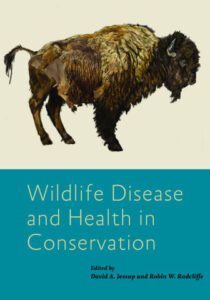 On the very same day that a copy of the newly published Wildlife Disease and Health in Conservation reached my desk for review, the top natural history story in the general news was the bleaching of corals off the coast of the U.S. state of Florida. Opening its cover to read through its table of contents, my sense of serendipity was immediately stimulated by discovering that following an introduction by one of the books co-editors, David Jessup, the very first full chapter is Thierry M. Work’s “Coral Reef Ecosystem Health.” We are, my dear readers, to the point where there is but one degree, of separation between what’s on the front page of the newspapers (please forgive my archaic metaphor, I’m old) and what’s among the most prominent topics in wildlife conservation, as as journalism operates on the principle of “if it bleeds, it leads,” that doesn’t say anything good about the state of the planet and those who live upon it.
On the very same day that a copy of the newly published Wildlife Disease and Health in Conservation reached my desk for review, the top natural history story in the general news was the bleaching of corals off the coast of the U.S. state of Florida. Opening its cover to read through its table of contents, my sense of serendipity was immediately stimulated by discovering that following an introduction by one of the books co-editors, David Jessup, the very first full chapter is Thierry M. Work’s “Coral Reef Ecosystem Health.” We are, my dear readers, to the point where there is but one degree, of separation between what’s on the front page of the newspapers (please forgive my archaic metaphor, I’m old) and what’s among the most prominent topics in wildlife conservation, as as journalism operates on the principle of “if it bleeds, it leads,” that doesn’t say anything good about the state of the planet and those who live upon it.
Published in association with The Wildlife Society, David A. Jessup’s and Robin W. Radcliffe’s Wildlife Disease and Health in Conservation is first and foremost a textbook in the subject for those studying or working in the fields of wildlife biology, wildlife management, and ecology. However given the dramatic increase in how frequently such diseases as coral bleaching, sea star wasting disease, chronic wasting disease, bovine brucellosis, white-nose syndrome, avian influenza, and toxoplasmosis appear in popular news reports, as well as the increased interest in zoonotic transmissions of diseases following the CoVid-19 pandemic, this is a book that has much to offer any interested naturalist in order to gain a better informed understanding of what such diseases are, how they act, and the effects they have on wildlife.
